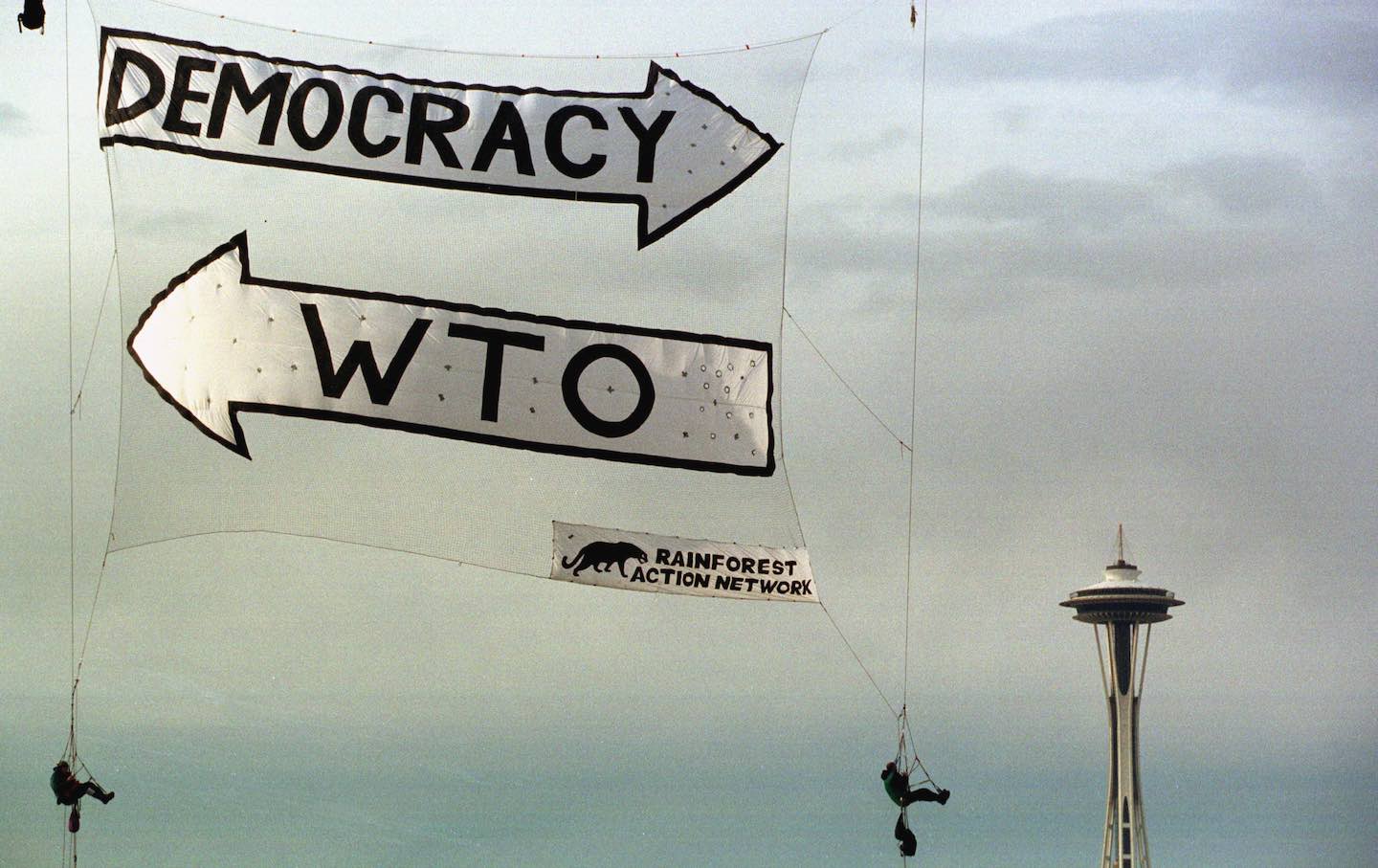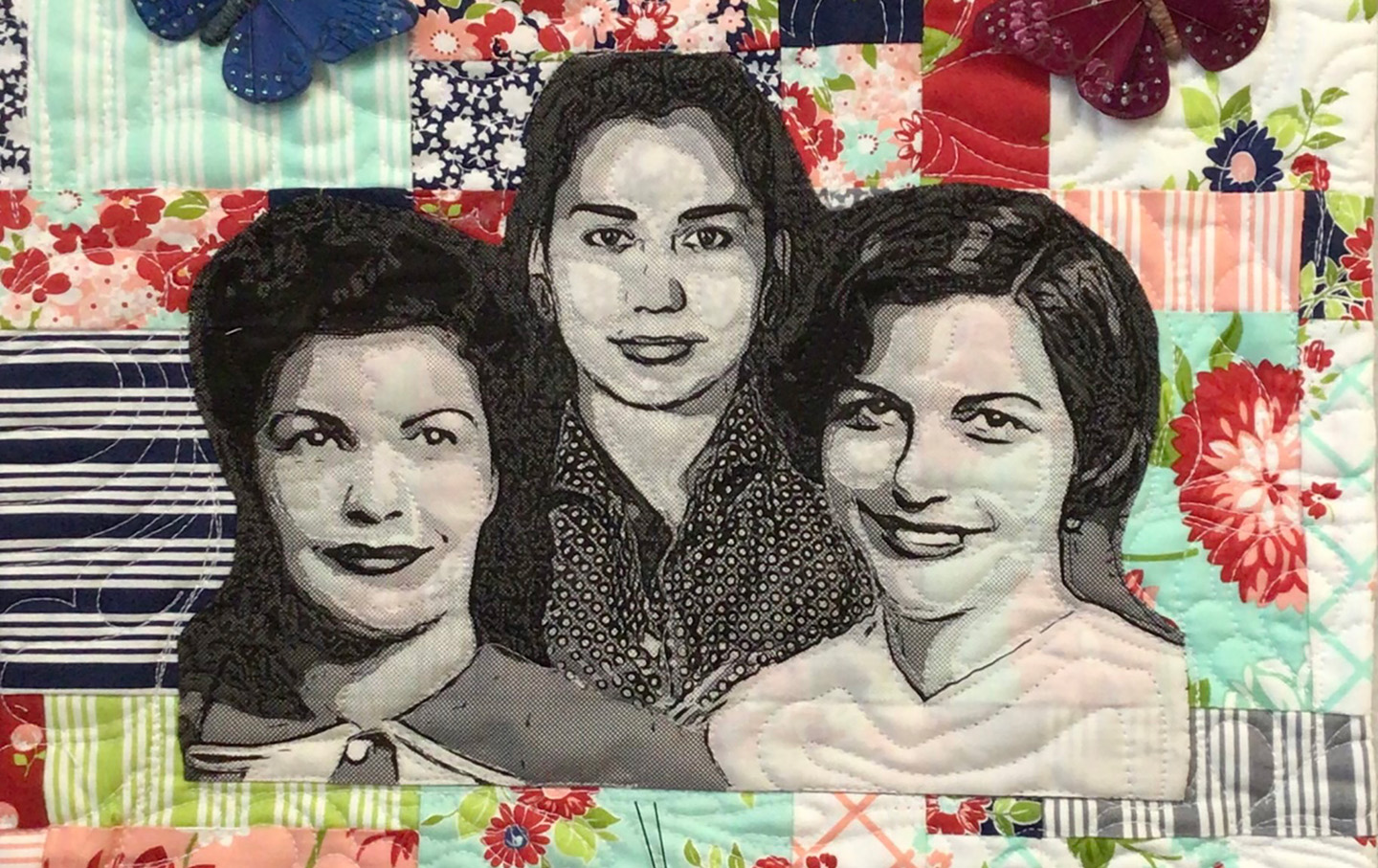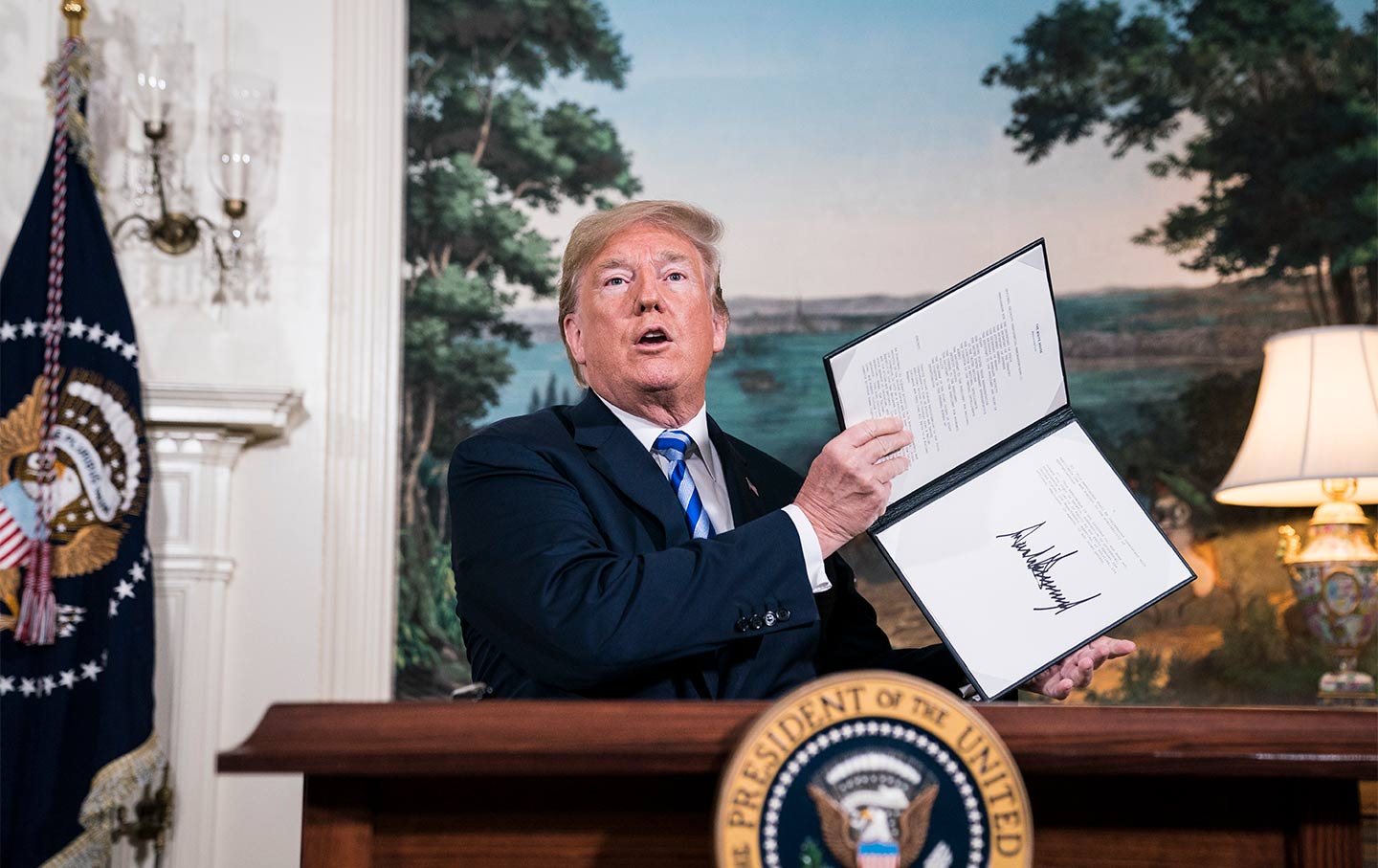The protests against the WTO Conference in 1999 were short-lived. But their legacy has reverberated through American political life ever since.

Members of the Rainforest Action Network putting up a banner in front of the Seattle Space Needle in November 1999.
(Sion Touhig/Sygma via Getty Images)
November 30, 1999, was supposed to be the first day of the World Trade Organization’s Ministerial Conference in Seattle. Normally, “the World Trade Organization’s Ministerial Conference in Seattle” was the sort of boring phrase I would have heard Jim Lehrer say as my parents watched NewsHour. At age 11, I was more interested in collecting Pokémon cards. But things didn’t go normally. The diplomats assembled at the Washington State Convention and Trade Center were met by at least 40,000 organized protesters from all over the world, including anti-sweatshop activists, unions, environmental organizations, anarchists, Indigenous rights groups, artists, students, farmers, and progressive religious leaders.
There were drum circles and papier-mâché puppets, permitted marches and unauthorized actions. A group of Teamsters danced in the street with a group of environmentalists dressed like turtles. Members of the Rainforest Action Network scaled a crane hundreds of feet high to suspend a giant banner that had two arrows: one pointing toward “WTO,” the other toward “DEMOCRACY.” The next day, a photo of the banner was on the front page of The Wall Street Journal.
Groups of protesters blocked intersections and locked their hands together inside homemade “lockboxes” made of chains, carabiners, and PVC pipe segments. The protests delayed the conference’s opening ceremony, and Secretary of State Madeleine Albright got trapped in her hotel room. In order to clear the intersections and get the conference underway, police responded with tear gas, pepper spray, batons, projectiles, and mass arrests. Black bloc anarchists broke windows at Starbucks and set fires at NikeTown. The cops ran out of tear gas, and the National Guard was called in. The city was put under a curfew, and sales of gas masks were banned. The Battle of Seattle, as it came to be called, continued until the conference ended on December 3.
The events produced spectacular imagery of urban warfare. Video footage of raging fires, billowing tear gas, anti-capitalist graffiti, and black-clad anarchists fighting in the street with phalanxes of police in riot gear were shown on the news worldwide. Kids talked about it on the bus to school that week. I don’t know if this was the first time ever that trade policy was discussed by a group of middle-schoolers, but it was a first for me.
“Yo, they were like, setting fires and stuff,” a boy in a Korn shirt announced to his friend with spiked hair. “This one dude kicked in a window at a Starbucks.”
At the time, the scenes from Seattle made me uneasy. Why, I wondered, would anyone vandalize a Starbucks? And what were the protesters so angry about?
“You know that banner that showed, like, capitalism going in one direction and democracy going in the other?” Quinn Slobodian, a professor of history at Boston University and the author of Crackup Capitalism: Market Radicals and the Dream of a World Without Democracy, asked me. “The WTO was supposed to be the embodiment of that. The way that the international trade community saw it themselves was that the WTO and international economic law was democratically legitimate because it had been turned into law by democratically elected governments.”
That all started in 1948. Originally named the General Agreement on Tariffs and Trade, or GATT, the organization served as a forum for governments to negotiate trade agreements and settle trade disputes. In the shadow of the Second World War, such an organization served an obvious peacekeeping function. In 1995, the GATT was renamed the World Trade Organization, and by 1995, its numbers had swelled from 23 member states to 135. During that decade, its scope was expanded to cover not only trade in goods but also services, as well as intellectual property, such as patents for seeds, software, or medicines. It also began meeting more frequently—typically every two years, with the first Ministerial Conference held in Singapore in 1996. When it was announced that the next conference would be held in Seattle—a formerly blue-collar town that had recently become the headquarters of Microsoft, Starbucks, Amazon, and grunge music—activists got to work planning a response.
“A lot of the conversation [among protesters] was around how deeply antidemocratic the WTO governing body was,” said Nancy Haque, a founding member of the Direct Action Network (DAN), an umbrella network of affinity groups that planned many of the more disruptive nonviolent actions in 1999, such as blocking intersections. “Having a few judges who are appointed, not elected, deciding these rules which actually matter to people was a deeply unfair system.”
But the way the WTO functioned was not the primary concern of the protesters. The real issue was the role they felt the WTO played in policies that shut down unionized factories in developed countries and outsourced the labor to poor nations with few labor or safety protections, or the way that certain trade agreements priced in environmental destruction as an externality.
A significant number of the protesters in Seattle had gotten their start in the anti-sweatshop movement. Throughout the 1990s, clothing manufacturers started shifting their manufacturing from rich countries with lots of regulations to poor countries with few regulations. As this happened, a series of prominent media exposés brought attention to labor abuses inside these factories. A 1992 Harper’s Magazine article by Jeff Ballinger profiled an Indonesian worker in a Nike factory who worked 10-hour days, six days a week, and yet made only $37.46 a month—half the retail price of a pair of Nike sneakers at the time.
The brand-new technology of at-home Internet allowed people who were outraged by this state of affairs to connect via e-mail, listservs, and websites. Anti-sweatshop activism became popular among college students, and in 1998, the group United Students Against Sweatshops (USAS) was founded. This organization pressured universities to purchase their branded apparel from factories with fair labor practices. It also served as an incubator for left activism.
Months before the conference started, groups like DAN and USAS started planning. Activists organized camps up and down the West Coast. They built giant puppets, painted signs, learned how to rappel from tall structures, and held teach-ins. They got large maps of Seattle and planned how they would converge on the convention center where the meeting would be held.
A decade earlier, Francis Fukuyama had famously announced “the end of history.” What he meant was that liberal democracy and an increasingly deregulated free market capitalism were “the end point of mankind’s ideological evolution” and “the final form of human government.” When the Soviet Union fell in 1991 and left the United States the sole global leader, this seemed to confirm Fukyuama’s thesis. Throughout the ’90s, there was a widespread sense that, as Margaret Thatcher had put it, there was “no alternative”—a notion that the late scholar Mark Fisher called “capitalist realism.”
The protests of 1999 were a rejoinder to that consensus. Sweatshops, the protesters argued, had no place in a democracy; nor did closed-door deals that created the rules governing daily life for people around the world. Doug Henwood, who was in Seattle to cover the protests for The Nation, told me that Seattle marked the first time he heard crowds of people chanting the now-ubiquitous protest slogan “This is what democracy looks like.” That slogan gave its name to a 2000 documentary directed by Jill Friedberg and Rick Rowley, consisting of footage from 100 media activists. (In my opinion, This is What Democracy Looks Like is dated and melodramatic, with its POV camera angles and trip-hop soundtrack, but it is a useful primary source.)
“I think the misconception about our movement at the time was that we were actually anti globalization,” Haque told me. “We were not anti globalization. We’re anti corporate globalization. We’re anti rules that always favored corporations over people. The voices of people most affected by the decisions [the WTO] made were never being heard.”
Slobodian told me something similar. “It’s about, how do you connect class-based politics across borders and build possibilities for justice and redistribution?”
Many of these nuances were lost in the media coverage of the protests. Thomas Friedman’s December 1 column for The New York Times was titled “Senseless in Seattle.” “Is there anything more ridiculous in the news today then [sic] the protests against the World Trade Organization in Seattle? I doubt it,” he wrote. Friedman went on to describe the protesters as a coalition of cranks and naïve idealists who were simply incapable of understanding how trade would have to work in an Internet-connected, post–Cold War world.
“The protests in Seattle were supposed to adhere to a schedule, a plan, a choreography,” wrote Joel Achenbach at The Washington Post. “The schedule did not mention rioting.”
Achenbach, like Friedman, characterized the protests as laughable and dated, a relic of the ’60s. “Confusing the situation is our general lack of understanding of two key facts about the World Trade Organization: 1. What it is. 2. What it is that we are not supposed to like about it,” Auchenbach wrote.
But President Bill Clinton seemed to comprehend the protesters’ demands better than most pundits (or at least he wanted to look like he did).
“What they are telling us in the streets is that this is an issue we’ve been silent on,” Clinton told the ministerial conference over lunch on December 1. “And we won’t be silent anymore. The sooner the WTO opens up the process and lets people representing those who are outside in, the sooner we will see fewer demonstrations, more constructive debate, and a broader level of support in every country for the direction that every single person in this room knows that we ought to be taking into the 21st century.”
That may not have been an entirely credible statement from the man who had signed the North American Free Trade Agreement in his first term. But it was a sign of how far the ripples had spread.
“I thought we finally did something to put some points on the board right at the whistle at the end of the millennium,” activist John Sellers told D.W. Gibson for his recent oral history of the protests, One Week to Change the World. “Maybe this is the sign of better things to come.”
But to some observers—even sympathizers—the movement’s weaknesses may have hindered its impact. “The whole culture never had a positive vision of what society should look like,” Henwood told me. “It was all very vague. I think having a body to regulate world trade is a good idea, even if the WTO’s setup isn’t the right one. Yes, the WTO’s structure made it too capital-friendly, but the underlying concept isn’t a bad one.”
Still, there was a sense that space had opened up, that history hadn’t ended. Invigorated by what they pulled off in Seattle, activist groups made it a goal to shut down all similar conferences: the IMF and World Bank summit in Prague in September 2000, the Free Trade Area of the Americas summit in Quebec City in April 2001, the G8 Summit in Genoa in July 2001.
“Many of us felt like we were winning, that momentum was on our side,” wrote activist L.A. Kauffman in a 2011 n+1 essay.
Popular
“swipe left below to view more authors”Swipe →
And then one of the most visible symbols of globalization, New York’s World Trade Center, came crashing down.
“The shift in public mood after 9/11 had much to do with this rapid decline,” wrote Kauffman.
“It didn’t feel right to protest,” Haque said.
At a time when Susan Sontag and the Dixie Chicks were being branded as traitors, and President George W. Bush told us to express our patriotism by “get[ting] down to Disney World,” few Americans wanted to hear—or felt safe raising—complaints about the economic system.
Activism also shifted to the more immediate issues around the Global War on Terror, with the globally coordinated protests against the Iraq War in early 2003 taking up most of the energy of the organized left. The door that was cracked open in Seattle seemed to slam shut. It would remain closed for another decade.
In September 2011, I first heard about Occupy Wall Street on Twitter. I was graduating from the University of Vermont at the end of the fall semester, and staring down an economy where national unemployment had recently been at 10 percent. We were in the ruins of the 2008 recession, during which around 3.8 million American families lost their homes to foreclosure and Americans lost $14 trillion of net worth. And millennials like me were entering these dire economic conditions with, on average, tens of thousands of dollars worth of high-interest student loan debt. In 1999, I’d had no reason not to believe that the people who set the rules of the global economy did not have my best interests at heart, because these rules appeared, at that moment at least, to benefit me and my family. But by 2011, everything seemed to have flipped.
Millennials grew up with the story that unregulated capitalism and democracy were the same thing. But Occupy Wall Street appealed to many millennials because it told a different story—the same story that the WTO protests had been trying to tell in 1999. At its broadest, it was a story about democracy. Why were the rules of our economy written so that most people didn’t have a say? Why were our economic rules making people less prosperous, stable, and safe? And, given that most people didn’t have a say in deciding these rules, how could we say we had a democracy in any real sense?
In the end, Occupy was cleared with the same tactics used in Seattle—tear gas, pepper spray, mass arrests. But the ideas it popularized were taken up and made even bigger by the Bernie Sanders campaign, the renewed labor movement, and the Black Lives Matter movement. Leftist (or just non-neoliberal) ideas about economics have become part of public discourse in a way that was hard to imagine under the administrations of Clinton or Bush.
When I was 11, I thought the protesters in Seattle did what they did because they hated democracy. What I’ve come to realize is that what they wanted was a deeper democracy, a democracy that wasn’t just about voting but about people having a say at work and in their communities. I may not agree with everything that happened in Seattle—I remain skeptical about drum circles, puppets, vandalism, and the need to get rid of the WTO tout court. But when I look out at our chaotic world in 2024, I wonder if we can all admit that the protesters may have been on to something in 1999.
We cannot back down
We now confront a second Trump presidency.
There’s not a moment to lose. We must harness our fears, our grief, and yes, our anger, to resist the dangerous policies Donald Trump will unleash on our country. We rededicate ourselves to our role as journalists and writers of principle and conscience.
Today, we also steel ourselves for the fight ahead. It will demand a fearless spirit, an informed mind, wise analysis, and humane resistance. We face the enactment of Project 2025, a far-right supreme court, political authoritarianism, increasing inequality and record homelessness, a looming climate crisis, and conflicts abroad. The Nation will expose and propose, nurture investigative reporting, and stand together as a community to keep hope and possibility alive. The Nation’s work will continue—as it has in good and not-so-good times—to develop alternative ideas and visions, to deepen our mission of truth-telling and deep reporting, and to further solidarity in a nation divided.
Armed with a remarkable 160 years of bold, independent journalism, our mandate today remains the same as when abolitionists first founded The Nation—to uphold the principles of democracy and freedom, serve as a beacon through the darkest days of resistance, and to envision and struggle for a brighter future.
The day is dark, the forces arrayed are tenacious, but as the late Nation editorial board member Toni Morrison wrote “No! This is precisely the time when artists go to work. There is no time for despair, no place for self-pity, no need for silence, no room for fear. We speak, we write, we do language. That is how civilizations heal.”
I urge you to stand with The Nation and donate today.
Onwards,
Katrina vanden Heuvel
Editorial Director and Publisher, The Nation
More from The Nation

Amin El Gamal, head of SAG-AFTRA’s committee on Middle Eastern and North African members, has advocated for a statement supporting a ceasefire in Gaza—so far without success

Patria, Minerva, and María Teresa Mirabal were sisters from the Dominican Republic who opposed the dictatorship of Rafael Trujillo; they were assassinated on November 25, 1960, und…

In November, organizers at more than 18 universities met for a conference with Class Action to discuss how to democratize higher education.








